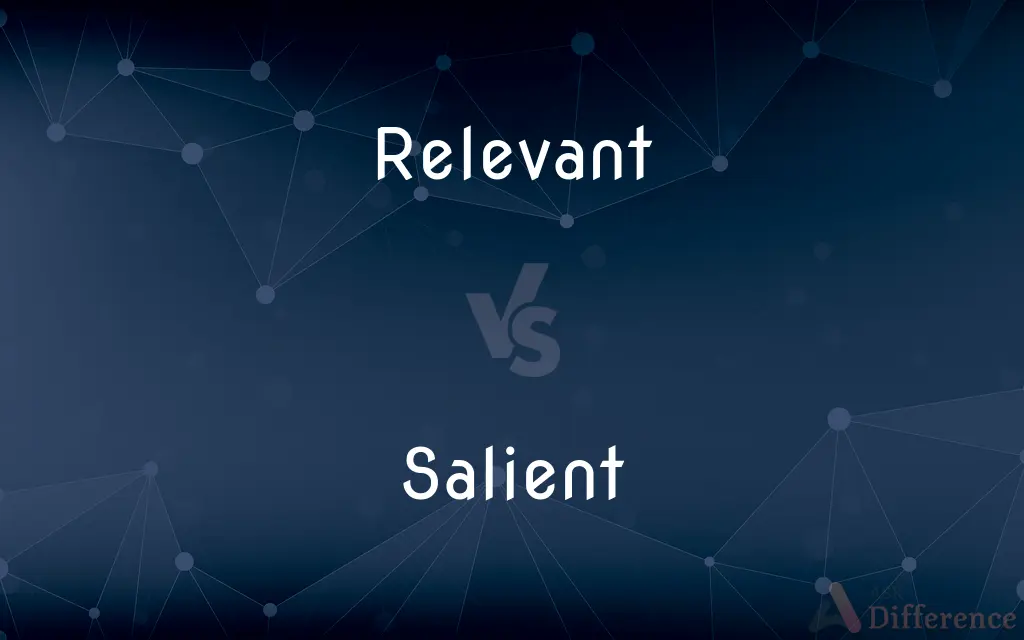Relevant vs. Salient — What's the Difference?
By Tayyaba Rehman & Maham Liaqat — Updated on April 25, 2024
"Relevant" refers to something closely connected or appropriate to the matter at hand, emphasizing applicability; "salient" highlights the most noticeable or important aspects, stressing prominence or significance.

Difference Between Relevant and Salient
Table of Contents
ADVERTISEMENT
Key Differences
Relevant information directly relates to and impacts the subject being discussed, ensuring that the content is pertinent to the current context. Whereas salient points stand out due to their prominence or significance, drawing attention to their importance within the larger context.
When assessing data for a report, relevant details are chosen for their direct connection to the topic's scope, aiding in creating a focused and effective argument. On the other hand, salient features are those that are most noticeable or impactful, often shaping the primary narrative or conclusions of the discussion.
In legal contexts, relevant evidence is necessary to support or refute a case, as it must directly pertain to the legal matter at issue. Meanwhile, salient aspects of a case might include key pieces of evidence or arguments that are particularly striking or persuasive to a jury or judge.
In education, a teacher might ensure that all material is relevant to the curriculum to maintain coherence and adherence to educational standards. Conversely, a teacher might highlight salient points during a lecture to capture and maintain student interest and emphasize critical aspects of the lesson.
Relevant topics in a business meeting are those that are directly associated with the agenda and necessary for decision-making. Conversely, salient points might be those that drastically affect the company’s strategy or are crucial for understanding market changes.
ADVERTISEMENT
Comparison Chart
Definition
Directly related to the matter at hand.
Most noticeable or important.
Focus
Pertinence and applicability.
Prominence and significance.
Usage in Context
Ensures information is appropriate and connected.
Highlights critical or impactful aspects.
Effect
Aids in maintaining relevance and focus.
Draws attention and clarifies importance.
Example
Information relevant to a specific research topic.
Salient features of a business proposal.
Compare with Definitions
Relevant
Necessary for understanding the context.
Including relevant examples can greatly enhance comprehension.
Salient
Most noticeable or important in a set of facts or ideas.
The salient points in her presentation captured everyone's attention.
Relevant
Related in a meaningful way.
The training provided relevant skills for the job.
Salient
Standing out conspicuously.
The salient features of the design were both innovative and practical.
Relevant
Directly connected to the subject at hand.
Ensuring all discussion points are relevant is crucial for the meeting's efficiency.
Salient
Easily noticed or important.
The most salient issue discussed was the need for increased security.
Relevant
Impactful to the matter being discussed.
His comments were particularly relevant during the debate.
Salient
Often synonymous with significant.
She emphasized the salient arguments for the change in policy.
Relevant
Appropriate to the current topic.
The article was relevant to my research, providing necessary data.
Salient
Prominent in terms of impact or interest.
His salient role in the project led to its success.
Relevant
Closely connected or appropriate to what is being done or considered
The candidate's experience is relevant to the job
What small companies need is relevant advice
Salient
Noteworthy; important
The salient points of the argument.
Relevant
Having a bearing on or connection with the matter at hand.
Salient
Prominent; conspicuous.
Relevant
Meaningful or purposeful in current society or culture
Thought that the traditional male role of breadwinner was no longer relevant.
Salient
Projecting or jutting beyond a line or surface; protruding
The salient angles of the polygon.
Relevant
Related, connected, or pertinent to a topic.
Salient
Springing; jumping
Salient tree toads.
Relevant
(Usually and especially) Directly related, connected, or pertinent, with important ramifications or implications.
His mother provided some relevant background information concerning his medical condition.
Salient
A military position that projects into the position of the enemy.
Relevant
Not out of date; current.
Salient
A projecting angle or part.
Relevant
Relieving; lending aid or support.
Salient
Worthy of note; pertinent or relevant.
The article is not exhaustive, but it covers the salient points pretty well.
Relevant
Bearing upon, or properly applying to, the case in hand; pertinent; applicable.
Close and relevant arguments have very little hold on the passions.
Salient
Prominent; conspicuous.
Relevant
Sufficient to support the cause.
Salient
Depicted in a leaping posture.
A lion salient
Relevant
Having a bearing on or connection with the subject at issue;
The scientist corresponds with colleagues in order to learn about matters relevant to her own research
Salient
Projecting outwards, pointing outwards.
A salient angle
Relevant
Having crucial relevance;
Crucial to the case
Relevant testimony
Salient
(obsolete) Moving by leaps or springs; jumping.
Salient
(obsolete) Shooting or springing out; projecting.
Salient
(geometry) Denoting any angle less than two right angles.
Salient
(military) An outwardly projecting part of a fortification, trench system, or line of defense.
Salient
(geography) An elongated protrusion of a geopolitical entity, such as a subnational entity or a sovereign state.
Salient
Moving by leaps or springs; leaping; bounding; jumping.
Salient
Shooting out or up; springing; projecting.
He had in himself a salient, living spring of generous and manly action.
Salient
Hence, figuratively, forcing itself on the attention; prominent; conspicuous; noticeable.
He [Grenville] had neither salient traits, nor general comprehensiveness of mind.
Salient
Projecting outwardly; as, a salient angle; - opposed to reëntering. See Illust. of Bastion.
Salient
Represented in a leaping position; as, a lion salient.
Salient
A salient angle or part; a projection.
Salient
(military) the part of the line of battle that projects closest to the enemy
Salient
Having a quality that thrusts itself into attention;
An outstanding fact of our time is that nations poisoned by anti semitism proved less fortunate in regard to their own freedom
A new theory is the most prominent feature of the book
Salient traits
A spectacular rise in prices
A striking thing about Picadilly Circus is the statue of Eros in the center
A striking resemblance between parent and child
Salient
(of angles) pointing outward at an angle of less than 180 degrees
Salient
Represented as leaping (rampant but leaning forward)
Common Curiosities
Can the saliency of a point change over time?
Yes, what is considered salient can change as the context or priorities shift.
What makes information relevant?
Information is relevant if it directly relates to and is useful for understanding or resolving the matter being discussed.
What techniques can be used to ensure information remains relevant?
Continual review and adaptation of content to align with evolving topics or standards help maintain relevance.
How can one differentiate between relevant and irrelevant data?
By assessing the direct connection of the data to the main subject and its contribution to understanding or solving the issue.
How do educators determine what is relevant for their curriculum?
Educators align material with educational standards and learning objectives to ensure relevance.
How do professionals ensure they communicate relevant information?
Professionals tailor their communication by understanding the audience's needs and the objectives of the interaction.
Why is it important to identify salient points?
Identifying salient points helps prioritize information, focusing attention on what is most significant or impactful.
What role do salient points play in decision-making?
Salient points often guide decision-making by highlighting the most critical aspects that need consideration.
How can one highlight salient points in a presentation?
Using visual aids, emphasizing through repetition, and structuring the presentation to foreground these points can highlight their salience.
What are examples of salient features in product design?
In product design, salient features might include unique functionalities, design innovations, or aspects that significantly enhance user experience.
Can something be salient but not relevant?
Yes, a point can be striking or prominent (salient) without being directly connected to the current discussion (relevant).
Is relevance subjective in discussions?
Relevance can be somewhat subjective, depending on each participant's perspective and the context of the discussion.
What is the impact of including only relevant information in research?
Including only relevant information ensures the research is focused, credible, and informative.
How does relevance affect the outcome of legal proceedings?
Relevance determines the admissibility of evidence, impacting the legal arguments and possibly the outcome of the case.
What are the consequences of ignoring salient points in analysis?
Ignoring salient points can lead to incomplete analysis and potentially flawed conclusions or decisions.
Share Your Discovery

Previous Comparison
Applicable vs. Relevant
Next Comparison
Slim vs. TrimAuthor Spotlight
Written by
Tayyaba RehmanTayyaba Rehman is a distinguished writer, currently serving as a primary contributor to askdifference.com. As a researcher in semantics and etymology, Tayyaba's passion for the complexity of languages and their distinctions has found a perfect home on the platform. Tayyaba delves into the intricacies of language, distinguishing between commonly confused words and phrases, thereby providing clarity for readers worldwide.
Co-written by
Maham Liaqat













































